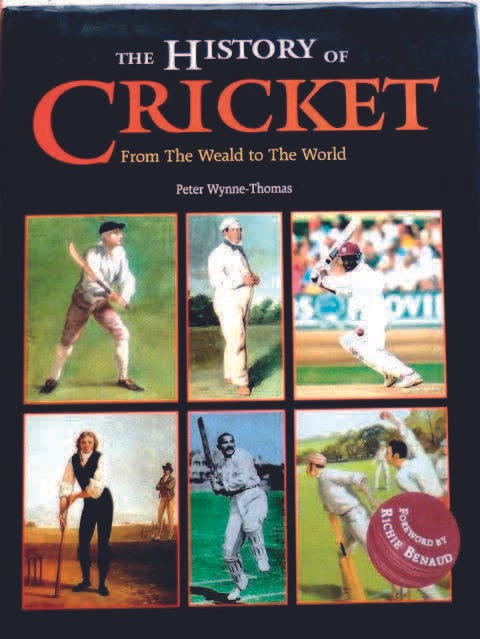Each week we spotlight a fascinating title from the vast collection catalogued in the Cricket Bibliography project, drawing on insightful (but not necessarily positive!) reviews from the archives of our journal. Today we bring you Robert Brooke on Peter Wynne-Thomas’s The History of Cricket (1997).
Surprisingly, there are a mere seven books titled ‘History of Cricket’ in the two published volumes of Padwick, but numerous other volumes—for instance Rowland Bowen’s Cricket A History of Its Growth and Development—are, or purport to be, Histories of one form or another.
It might therefore be thought that enough is enough, that we know everything there is to know about cricket, that there is nothing to be discovered. This view was first expressed more than 100 years ago, and it is perhaps as nonsensical now as then.
Certainly this latest history should make such an impact that the belief that there had been enough such books in past times is revealed as uninformed rubbish.
The first shock comes very early, with a picture from a mid-14th century manuscript, showing a group of people who could, with a large dollop of imagination, be taken as playing a rudimentary from of ‘cricket,’ or at least ‘club-ball.’ The author reveals the original of this picture, in the borders of the Romance of Alexander, from circa 1340, showing that the picture which appeared in Joseph Strutt’s Sports & Pastimes book of 1801 was ‘doctored’ to make it look more like cricket. Not only that; this reviewer feels that the object held by the ‘bowler’ could well be a baby, rather than a ball!
The most important contention in Wynne-Thomas’ book follows, when he takes the view that although cricket was undoubtedly a Wealden game in the 17th century, it was not, as has been previously surmised, a game played by shepherds while watching their flocks, but more likely by the workers in the iron industry. One had in fact often wondered about this; apart from the fact that they would be neglecting their sheep, shepherds were surely comparatively few and far between. On the other hand, industrial workers could far more easily gather in numbers, possibly in the forest clearings brought about by felling trees for charcoal. From a personal point of view this theory seems to square with one propounded to this reviewer some twenty years or more ago. In brief, a correspondent (whose name I do not now recall) wrote to me asking about ‘Forest Cricket,’ and specifying the South East of England. Could this have been from someone whose conclusions matched those of Wynne-Thomas, but who was ‘testing the water’? Unfortunately, this reviewer in his ignorance replied to the effect that he had never heard of ‘Forest Cricket,’ and that he knew not about what the correspondent was talking, and please send more information. That information never came; it now seems possible—if no more than that—that this unknown correspondent had hit upon something of great importance, but that one Robert Brooke, editor of The Cricket Statistician, hadn’t the wit to recognise it.
The second item of great importance in this new history concerns the founding of MCC. Few people, if any, have ever bothered to undertake any proper research on this matter, many so-called historians wrongly thinking that the founding of the club which became MCC, had something to do with the first ground bearing the name of Thomas Lord. It didn’t, and Wynne-Thomas’s suggestions for the early years of the cricket club seem convincing. From the evidence one can surmise that the club which continues today as ‘MCC’ was founded nearly fifty years before Lord laid out his first ground.
These are the most important conclusions reached in this new history. One hopes, without much conviction, they will be accepted. One awaits with interest the appearance of future histories from the pen of the next pop musician or popular composer to decide to enter the fray. If he should grab the right book off the shelf, all may be well. Unfortunately there are far too many publications offering an ‘alternative’ history of cricket.
The present book is recommended unconditionally, but lest it be thought this reviewer overpraises, there are one or two comments he would wish to make.
On page 8, Wynne-Thomas repeats the story of Bishop Ken playing cricket at Winchester in the mid-17th century. He may have done so, but one was under the impression that this particular reference was culled from a ‘fictionalised’ biography in Schooldays of Eminent Men.
Then, on page 9, the author states that the first claimed ‘inter-county’ match, in 1709, ‘probably has a title it scarcely deserves.’ How does he know, and in any event what was the contemporary definition of a ‘county’ match? Certainly the Postman newspaper for 29 June 1709 seems sure of itself as it announces ‘a famous match of cricket for £50, by Kent and Surrey’ on Dartford Brent.
Then, on page 19, some doubt is cast on whether a Hambledon XI played Dartford in August 1756. One would have thought it almost certain this was the match at which the dog of Revd. Keates, a spaniel called ‘Rover,’ was lost. (Was he ever found, one wonders?)
On page 41, Wynne-Thomas again casts doubt on the claimed cricket reference in William Byrd’s diary of 1709. This reviewer admits that there is some reason for debate, but it should surely be relevant that Byrd was from an old Kentish cricketing family, so he should have known whether or not he was playing a version of the game.
Finally, on page 144, we are told that the United States ceased the International series with Canada in 1912. This was a mere four years after ‘The Philadelphians’ held their own, at least against the weaker counties, on their 1908 tour of the UK. Surely the historian should at least hazard a guess as to the reason for this calamitous, and apparently sudden, collapse of American cricket…





https://substack.com/profile/256091022-harriet-thornton/note/c-127602508?r=48gx3i&utm_medium=ios&utm_source=notes-share-action